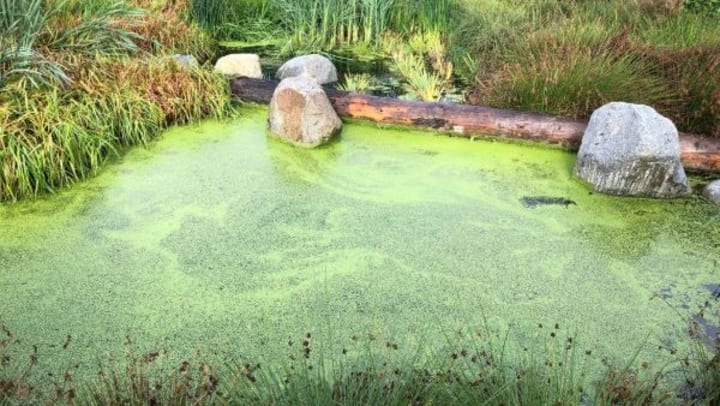The common types of pond algae
and the importance of blanket weed control

Algae is a diverse organism that has many different varieties. While some algae are considered beneficial for water ecosystems, others can have detrimental effects. We explore the common type of pond algae, alongside the importance of blanket weed control.
What is algae?

Algae refers to a diverse range of simple, non-flowering aquatic organisms that can photosynthesise. There are a wide range of algae. The exact number is hard to pinpoint, but it’s estimated there are between 3,000 to 1 million species. That’s a lot of different algae.
However, algae are typically categorised into 7 main categories or types. These are:
- Euglenophyta
- Chrysophyta
- Pyrrophyta
- Chlorophyta
- Rhodophyta
- Paeophyta
- Xanthophyta
Each type has distinct characteristics that set them apart. For example, Chlorophyta algae is typically green, whereas Rhodophyta is red. Each type can be distinguished by its colouring. However, unlike plants, algae lacks vascular tissue, roots, stems, leaves, and flowers.
Algae can also differ in terms of its cell structure. Some types of algae are single cell whereas others are large multicellular species. As a result, algae can grow and thrive in a range of different aquatic environments, including fresh water, salt water, and wet soil.
Given how many different types of algae there are, you may already be familiar with some. This is especially the case for pond owners who can be plagued by algae blooms that can affect a pond's ecosystem. While some algae may be beneficial, others are not.
To help you better understand, we cover the common types of pond algae you are most likely to experience. We also explore the importance of blanket weed control.
Common types of pond algae
Green water algae

One of the first common types of pond algae you are likely to experience is green water algae. Green water algae (or planktonic) is a single-cell algae that typically floats in the water. As a result, this can give water a green or brownish colour.
Providing the right environment and conditions, planktonic algae can quickly bloom in a short time. This typically results from an excess of nutrients in the water. In large quantities, planktonic algae can be detrimental to a pond’s ecosystem.
However, given that many planktonic algae begin growing along the water’s edge or at the bottom of a pond or lake, it can be difficult to spot it early. Only once the algae has sufficient oxygen will it begin to appear on the water’s surface.
Severe planktonic algae blooms can be detrimental to fish. That’s because as the algae die and decay, it removes vital oxygen from the water. As a result, fish can suffer from hypoxia and even death.
Some common examples of planktonic algae include Chlorella, Scenedesmus, Dunaliella, Chlamydomonas, Ankistrodesmus, Eudorina, and Pandorina.
String algae

Another common type of algae you are likely to experience is string algae. Unlike planktonic algae, string algae grow in long strands and have a stringy appearance. Typically, string algae will grow from an attached surface, such as rocks.
As with most algae, in small amounts, string algae can be beneficial to your pond. However, it is large, excessive blooms that can become a problem. Unlike planktonic algae, sting algae is not a major danger to fish health. It can, though, be unsightly and affect the water quality. If not controlled, string algae can grow quickly doubling its weight in as little as 24 hours. Typically, string algae are mostly beneficial in natural ecosystems. In controlled environments, such as ponds, it can have an adverse effect.
It’s important to distinguish between string algae from good algae. Good algae will grow on the side of ponds and have a soft, jelly-like feel to it. String algae do not. If you experience string algae growing in your pond, it is important to take immediate action to prevent uncontrollable growth.
Some of the most common string algae you are likely to see include Spirogyra, Cladophora, Rhizoclonium, Pitophora, and Vaucheria.
Chara
Chara is another type of common algae you are most likely to find growing in freshwater, especially in limestone-heavy areas. They can easily be characterised due to their resemblance to land plants, especially due to their leaf and steam-like structure.
Chara most commonly grows in freshwater systems and is one of the most widely known macroalgae around. You can characterise Chara algae by the thick mats that it forms. This algae also stays submerged in the water and can provide food for fish.
However, it can grow out of control and take over small garden ponds if left untreated. Chara will usually grow submerged in the muddy bottom of a freshwater source, especially in alkaline waters. It’s also able to grow in both shallow and deep water.
Some common types of Chara algae include Chara vulgaris, Chara fragilis, Chara corallina, Chara contaria, Chara hispida, and Chara tomentosa.
Euglena
One more type of common algae you may experience is Euglena. Euglena is a single-celled type of algae that grows in freshwater, particularly in smaller bodies of water like ponds. Like other types of algae, Euglena thrives in water rich in nutrients.
Interestingly, Euglena can change colour by releasing granules from its centre to form a harder shell. This protects the algae from sun damage. This can happen in as little as 10 minutes changing from open green to closed red colouring.
However, Euglena is harmful to fish due to the fact it produces a harmful neurotoxin called euglenophycin. As a result, it’s important to remove this type of algae as quickly as possible due to the toxic algae blooms.
Examples of common euglena algae include Euglena gracilis, Euglena viridis, Euglena acus, Euglena sanguinea, Euglena mutabilis, and Euglena deses.
What is the importance of blanket weed control?

Blanket weed (or Spirogyra) is one of the most common types of algae that affects small water bodies, such as garden ponds. In large, uncontrollable blooms, these types of algae can be detrimental to your pond’s ecosystem and fish.
As a result, some form of blanket weed control is essential to maintain a healthy ecosystem and ensure sufficient oxygen. One method you can successfully manage blanket weed and prevent harmful outbreaks is through a blanket weed controller.
A blanket weed controller is a permanent solution to overcoming these detrimental algae blooms. This small device takes advantage of blanket weeds' simple cell structure and their calcium dependence.
The device is attached to the pond’s pump and filter system for the best result. It works by emitting a special low-frequency magnetic field that seeks to tip the balance blanket weed requires for growth.
A time-variant magnetic field works to reform the calcium to prevent new growth and disturb the metabolism of blanket weed. The field emitted from the device causes a sudden growth spurt that Spirogyra cannot sustain causing the weed to die as a result.
The device is safe to use alongside fish and aquatic plants ensuring a healthy ecosystem. The device is also easy to install and requires no plumbing. It also provides a low-cost, permanent solution to prevent further growth spurts of blanket weed.
The device also includes no moving parts and does not require any ongoing maintenance to keep the device functioning. Running the device only requires a small 3-watt power. It also ensures no algae blockages in your pond’s piping or filter system.
Want to find out more about blanket weed controllers? Check out these FAQs.
Many different types of algae can affect freshwater systems. Pond owners should pay particular attention to the algae types that can affect a healthy ecosystem and take appropriate measures to prevent damaging algae blooms. Opting for a blanket weed controller provides a sure way to prevent such damaging blooms.
About the Creator
Enjoyed the story? Support the Creator.
Subscribe for free to receive all their stories in your feed. You could also pledge your support or give them a one-off tip, letting them know you appreciate their work.





Comments
There are no comments for this story
Be the first to respond and start the conversation.